2012 Hyundai H-100 Truck tire type
[x] Cancel search: tire typePage 109 of 217
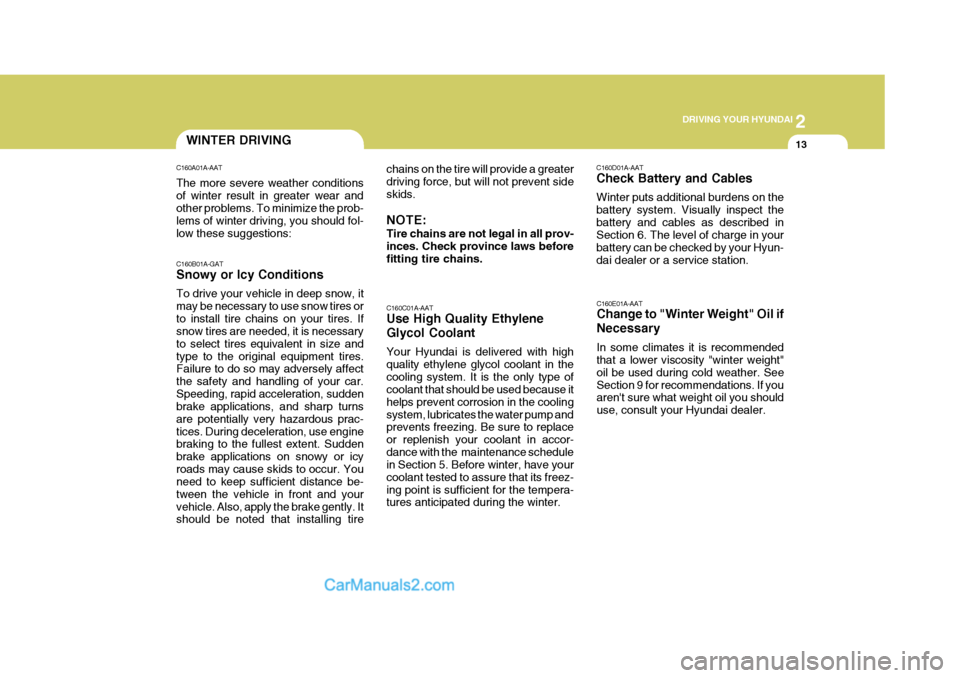
2
DRIVING YOUR HYUNDAI
13WINTER DRIVING
chains on the tire will provide a greater driving force, but will not prevent sideskids. NOTE: Tire chains are not legal in all prov- inces. Check province laws beforefitting tire chains. C160C01A-AAT Use High Quality Ethylene Glycol Coolant Your Hyundai is delivered with high quality ethylene glycol coolant in thecooling system. It is the only type of coolant that should be used because it helps prevent corrosion in the coolingsystem, lubricates the water pump and prevents freezing. Be sure to replace or replenish your coolant in accor-dance with the maintenance schedule in Section 5. Before winter, have your coolant tested to assure that its freez-ing point is sufficient for the tempera- tures anticipated during the winter.
C160A01A-AAT The more severe weather conditions of winter result in greater wear and other problems. To minimize the prob- lems of winter driving, you should fol-low these suggestions:
C160B01A-GAT Snowy or Icy Conditions To drive your vehicle in deep snow, it may be necessary to use snow tires orto install tire chains on your tires. If snow tires are needed, it is necessary to select tires equivalent in size andtype to the original equipment tires. Failure to do so may adversely affect the safety and handling of your car.Speeding, rapid acceleration, sudden brake applications, and sharp turns are potentially very hazardous prac-tices. During deceleration, use engine braking to the fullest extent. Sudden brake applications on snowy or icyroads may cause skids to occur. You need to keep sufficient distance be- tween the vehicle in front and yourvehicle. Also, apply the brake gently. It should be noted that installing tire C160D01A-AAT Check Battery and Cables Winter puts additional burdens on the battery system. Visually inspect thebattery and cables as described in Section 6. The level of charge in your battery can be checked by your Hyun-dai dealer or a service station.
C160E01A-AAT Change to "Winter Weight" Oil if Necessary In some climates it is recommended that a lower viscosity "winter weight" oil be used during cold weather. SeeSection 9 for recommendations. If you aren't sure what weight oil you should use, consult your Hyundai dealer.
Page 110 of 217
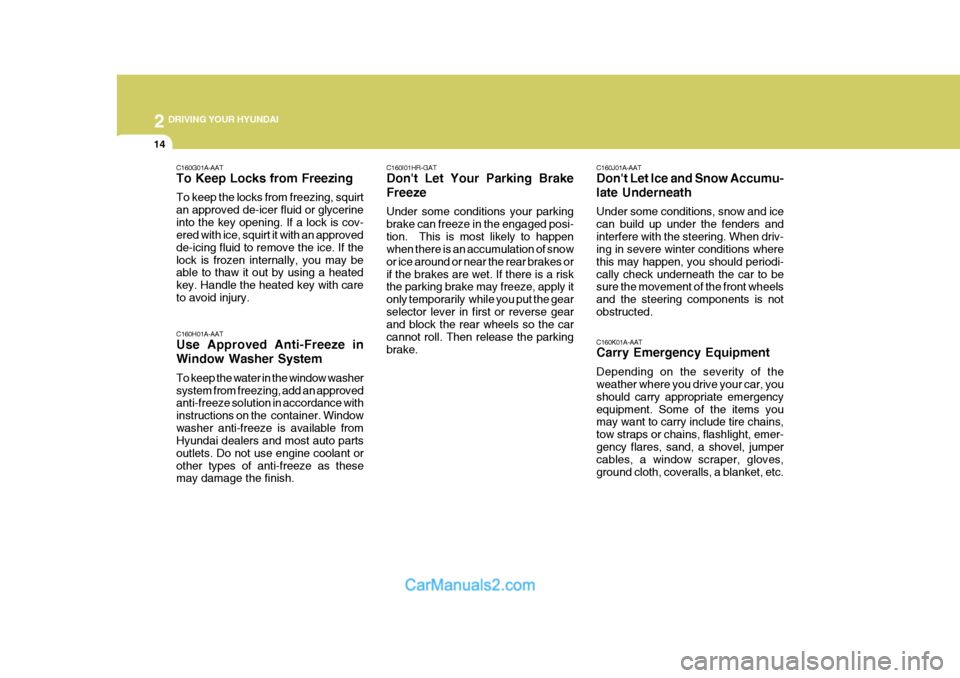
2 DRIVING YOUR HYUNDAI
14
C160K01A-AAT Carry Emergency Equipment Depending on the severity of the weather where you drive your car, you should carry appropriate emergencyequipment. Some of the items you may want to carry include tire chains, tow straps or chains, flashlight, emer-gency flares, sand, a shovel, jumper cables, a window scraper, gloves, ground cloth, coveralls, a blanket, etc.
C160J01A-AAT Don't Let Ice and Snow Accumu- late Underneath Under some conditions, snow and ice can build up under the fenders andinterfere with the steering. When driv- ing in severe winter conditions where this may happen, you should periodi-cally check underneath the car to be sure the movement of the front wheels and the steering components is notobstructed.
C160G01A-AAT To Keep Locks from Freezing To keep the locks from freezing, squirt an approved de-icer fluid or glycerineinto the key opening. If a lock is cov- ered with ice, squirt it with an approved de-icing fluid to remove the ice. If thelock is frozen internally, you may be able to thaw it out by using a heated key. Handle the heated key with careto avoid injury. C160H01A-AAT Use Approved Anti-Freeze in Window Washer System To keep the water in the window washer system from freezing, add an approved anti-freeze solution in accordance with instructions on the container. Windowwasher anti-freeze is available from Hyundai dealers and most auto parts outlets. Do not use engine coolant orother types of anti-freeze as these may damage the finish. C160I01HR-GAT Don't Let Your Parking Brake Freeze Under some conditions your parking brake can freeze in the engaged posi-tion. This is most likely to happen when there is an accumulation of snow or ice around or near the rear brakes orif the brakes are wet. If there is a risk the parking brake may freeze, apply it only temporarily while you put the gearselector lever in first or reverse gear and block the rear wheels so the car cannot roll. Then release the parkingbrake.
Page 111 of 217
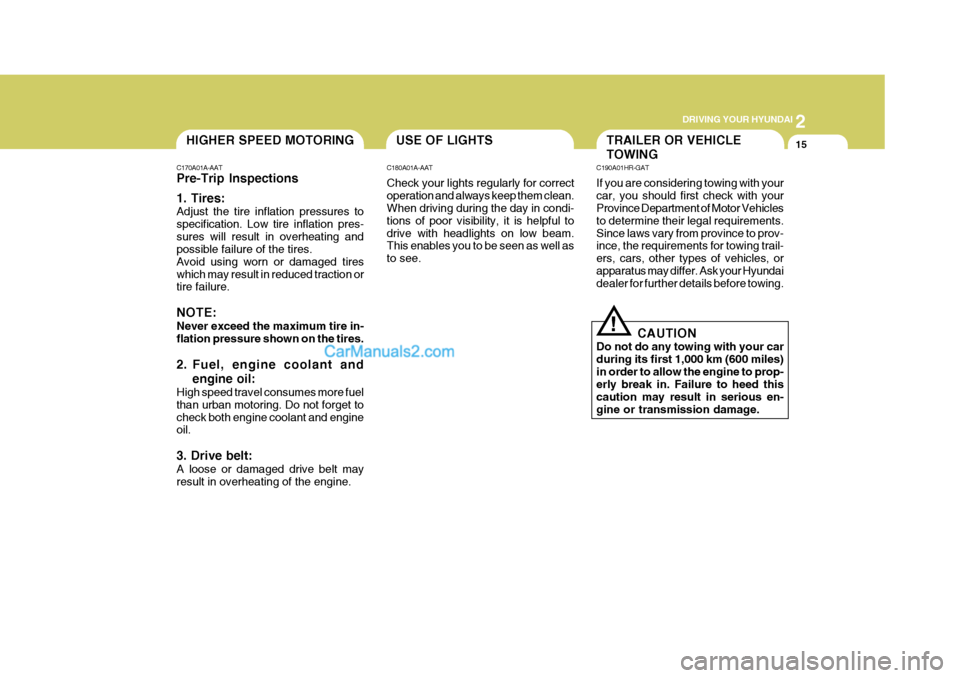
2
DRIVING YOUR HYUNDAI
15USE OF LIGHTSHIGHER SPEED MOTORING
C180A01A-AAT Check your lights regularly for correct operation and always keep them clean. When driving during the day in condi- tions of poor visibility, it is helpful todrive with headlights on low beam. This enables you to be seen as well as to see.
C170A01A-AAT Pre-Trip Inspections 1. Tires: Adjust the tire inflation pressures to specification. Low tire inflation pres-sures will result in overheating and possible failure of the tires. Avoid using worn or damaged tireswhich may result in reduced traction or tire failure. NOTE: Never exceed the maximum tire in- flation pressure shown on the tires.
2. Fuel, engine coolant and
engine oil:
High speed travel consumes more fuel than urban motoring. Do not forget tocheck both engine coolant and engine oil. 3. Drive belt: A loose or damaged drive belt may result in overheating of the engine.TRAILER OR VEHICLE TOWING
C190A01HR-GAT If you are considering towing with your car, you should first check with your Province Department of Motor Vehicles to determine their legal requirements.Since laws vary from province to prov- ince, the requirements for towing trail- ers, cars, other types of vehicles, orapparatus may differ. Ask your Hyundai dealer for further details before towing.
! CAUTION
Do not do any towing with your car during its first 1,000 km (600 miles)in order to allow the engine to prop- erly break in. Failure to heed this caution may result in serious en-gine or transmission damage.
Page 127 of 217

3 WHAT TO DO IN AN EMERGENCY
12
D060F03HR
(8) Press the piston down all the way and turn the release valve clock- wise as far as possible. HHR4018
Stop mark
CAUTION:
o Use only the jack included with the vehicle and use it only for changing a wheel.
o Position the jack on a hard level
surface.
o If the release valve is loosened by turning it 2 or more times inthe counterclockwise direction,the jack’s oil will leak and the jack cannot be used.!
D060F02HR
(7) Using the jack handle, turn the re- lease valve counterclockwise slow to lower the ram, and then take outthe jack. o This jack is hydraulic, and the ram
is a two-stage type. When both rams are raised and the stop mark(Green paint) of the upperram becomes visible, stop jack- ing immediately. Further exten- sion of the ram may damage thejack.
o When the jack is used, be sure that
there is no one in or under thevehicle.
o When jacking up the vehicle, do
so only until the tires are slightlylifted from the ground. It is dan- gerous to jack up the vehicle more than that much.
o It is very dangerous if the jack somehow slips, so never leave thevehicle in the jacked-up position,and never shake the vehicle while it is raised.
Page 209 of 217
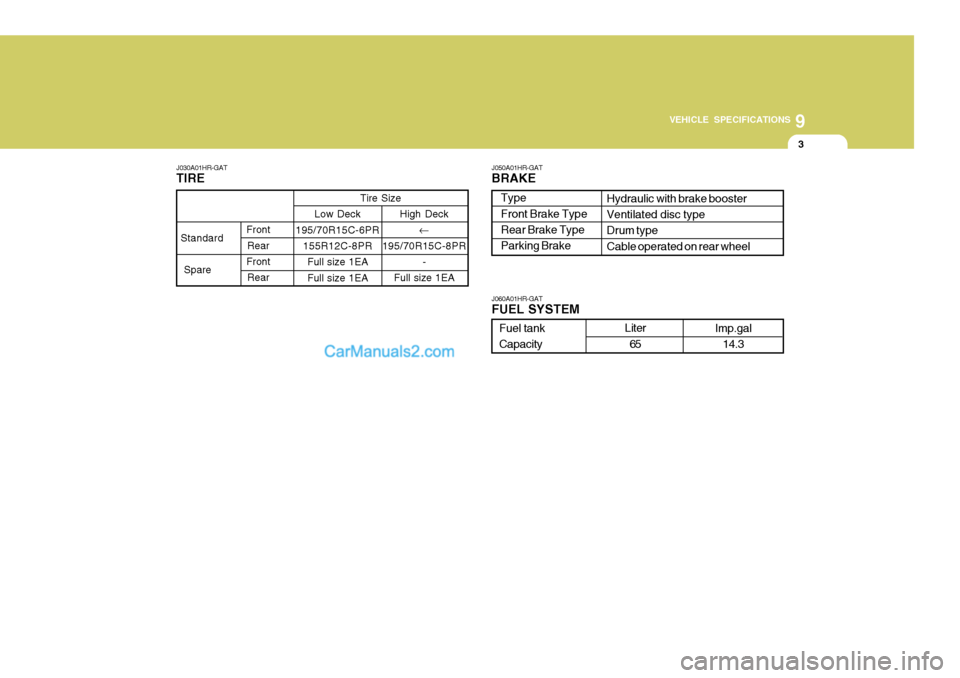
9
VEHICLE SPECIFICATIONS
3
J030A01HR-GAT TIRE
Hydraulic with brake booster Ventilated disc type Drum type Cable operated on rear wheel
J060A01HR-GAT FUEL SYSTEM
J050A01HR-GATBRAKE
Type Front Brake TypeRear Brake Type Parking Brake
Front Rear Front Rear Tire Size
Low Deck
195/70R15C-6PR 155R12C-8PR
Full size 1EAFull size 1EAStandard Spare
High Deck �
195/70R15C-8PR -
Full size 1EA
Fuel tank Capacity Liter
65 Imp.gal
14.3
Page 216 of 217
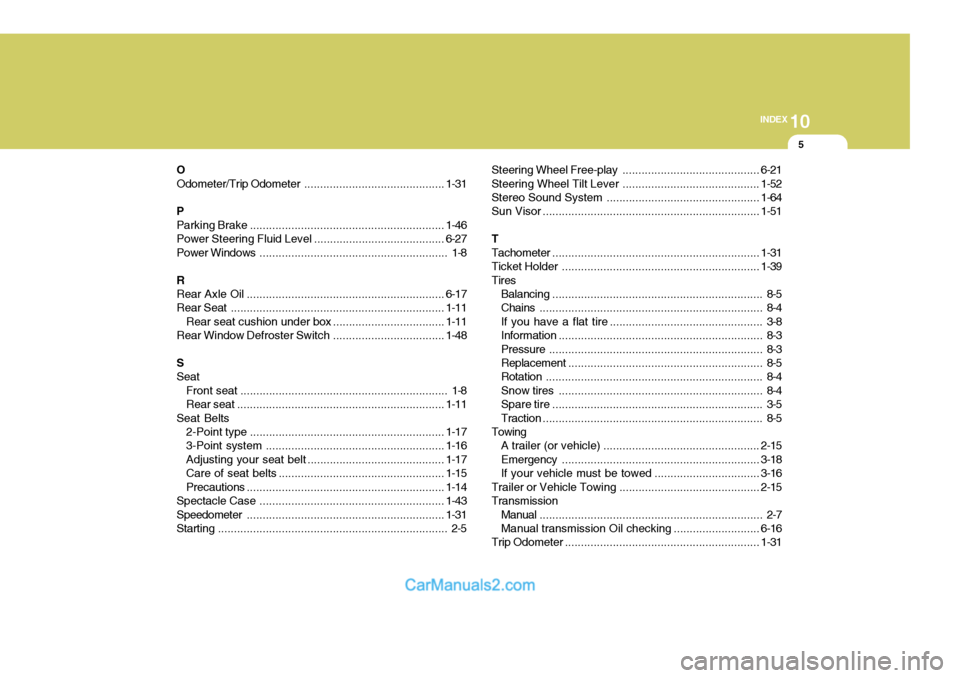
10
INDEX
5
O Odometer/Trip Odometer ............................................ 1-31
PParking Brake ............................................................. 1-46
Power Steering Fluid Level ......................................... 6-27
Power Windows ........................................................... 1-8
R Rear Axle Oi l .............................................................. 6-17
Rear Seat ................................................................... 1-11
Rear seat cushion under box ................................... 1-11
Rear Window Defroster Switch ................................... 1-48
S Seat Front seat ................................................................. 1-8Rear seat ................................................................. 1-11
Seat Belts 2-Point type ............................................................. 1-17
3-Point system ........................................................ 1-16
Adjusting your seat belt ........................................... 1-17
Care of seat belts .................................................... 1-15
Precautions .............................................................. 1-14
Spectacle Ca se .......................................................... 1-43
Speedometer .............................................................. 1-31
Starting ........................................................................ 2-5 Steering Wheel Free-play
........................................... 6-21
Steering Wheel Tilt Lever ........................................... 1-52
Stereo Sound System ................................................ 1-64
Sun Visor .................................................................... 1-51
TTachometer ................................................................. 1-31
Ticket Holder .............................................................. 1-39
Tires Balancing .................................................................. 8-5
Chains ...................................................................... 8-4
If you have a flat tire ................................................ 3-8
Information ................................................................ 8-3
Pressure ................................................................... 8-3
Replacement ............................................................. 8-5
Rotation .................................................................... 8-4
Snow tires ................................................................ 8-4
Spare tire .................................................................. 3-5
Traction ..................................................................... 8-5
Towing A trailer (or vehicle) ................................................. 2-15
Emergency .............................................................. 3-18
If your vehicle must be towed ................................. 3-16
Trailer or Vehicle Towing ............................................ 2-15
Transmission Manual ...................................................................... 2-7
Manual transmission Oil checking ........................... 6-16
Trip Odometer ............................................................. 1-31